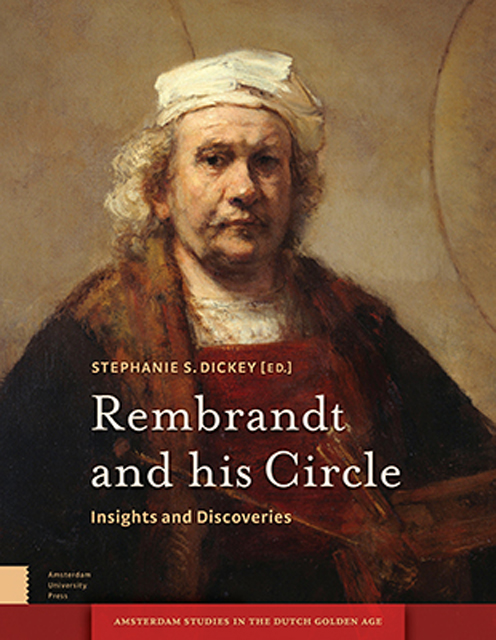Book contents
- Frontmatter
- Dedication
- Contents
- Acknowledgements
- Introduction
- 1 Rembrandt and Frans Hals Painting in the Workshop of Hendrick Uylenburgh
- 2 Rembrandt and the Germanic Style
- 3 Rembrandt and the Humanist Ideal of the Universal Painter
- 4 Curiosity and Desire: Rembrandt’s Collection as Historiographic Barometer
- 5 Painted Landscapes by Lievens and Rembrandt : The View from Seventeenth-Century Amsterdam Collections
- 6 Jan Lievens in Antwerp: Three Rediscovered Works
- 7 Gerrit Dou as a Pupil of Rembrandt
- 8 A New Painting by Jan van Noordt in Budapest
- 9 Rembrandt’s First Nude? The Recent Analysis of Susanna and the Elders from Rembrandt’s Workshop
- 10 Rembrandt’s Head of Christ: Some Technical Observations concerning Matters of Style
- 11 A Rediscovered Head of John the Baptist on a Platter from Rembrandt’s Studio
- 12 Rembrandt’s One Guilder Print: Value and Invention in ‘the most beautiful [print] that ever came from the burin of this Master’
- 13 Rembrandt, Ferdinand Bol, and Tobit: The Emergence of a Pathosträger
- 14 Biblical Iconography in the Graphic Work of Rembrandt’s Circle
- 15 Jan van Vliet and Rembrandt van Rijn: Their Collaboration Reassessed
- 16 Printmaking among Artists of the Rembrandt School
- 17 Chain Line Pattern Matching and Rembrandt’s Prints
- List of Illustrations
- Bibliography
- Index Nominum
13 - Rembrandt, Ferdinand Bol, and Tobit: The Emergence of a Pathosträger
Published online by Cambridge University Press: 21 January 2023
- Frontmatter
- Dedication
- Contents
- Acknowledgements
- Introduction
- 1 Rembrandt and Frans Hals Painting in the Workshop of Hendrick Uylenburgh
- 2 Rembrandt and the Germanic Style
- 3 Rembrandt and the Humanist Ideal of the Universal Painter
- 4 Curiosity and Desire: Rembrandt’s Collection as Historiographic Barometer
- 5 Painted Landscapes by Lievens and Rembrandt : The View from Seventeenth-Century Amsterdam Collections
- 6 Jan Lievens in Antwerp: Three Rediscovered Works
- 7 Gerrit Dou as a Pupil of Rembrandt
- 8 A New Painting by Jan van Noordt in Budapest
- 9 Rembrandt’s First Nude? The Recent Analysis of Susanna and the Elders from Rembrandt’s Workshop
- 10 Rembrandt’s Head of Christ: Some Technical Observations concerning Matters of Style
- 11 A Rediscovered Head of John the Baptist on a Platter from Rembrandt’s Studio
- 12 Rembrandt’s One Guilder Print: Value and Invention in ‘the most beautiful [print] that ever came from the burin of this Master’
- 13 Rembrandt, Ferdinand Bol, and Tobit: The Emergence of a Pathosträger
- 14 Biblical Iconography in the Graphic Work of Rembrandt’s Circle
- 15 Jan van Vliet and Rembrandt van Rijn: Their Collaboration Reassessed
- 16 Printmaking among Artists of the Rembrandt School
- 17 Chain Line Pattern Matching and Rembrandt’s Prints
- List of Illustrations
- Bibliography
- Index Nominum
Summary
Abstract
This article examines Ferdinand Bol's use of prototypes by Rembrandt and Maarten van Heemskerck during his workshop years and early career as an independent artist. Close analysis shows how he combined borrowings from existing sources to create an original work. The analysis focuses on two of Bol's most important paintings of the 1640s, The Women at the Tomb (1644, Copenhagen, Statens Museum for Kunst) and Saul and the Witch of Endor (c. 1645, whereabouts unknown). This examination reveals that Bol's starting point for both paintings was the literary source, and that his close reading of scripture inspired his choice of visual sources.
Keywords: Rembrandt van Rijn, Ferdinand Bol, Maarten van Heemskerck, drawing, Tobit, Tobias, Pathosträger
Ferdinand Bol, like most of Rembrandt's known pupils, used the master's work as a source for his own. In this essay I explore Bol's use of a single figure, Tobit as he appears in Rembrandt's painting of 1637, The Angel Raphael Leaving Tobit and his Family (fig. 13.1). This scene represents the concluding moment in the story, recounted in the Apocryphal Book of Tobit, of Tobias's search for an ointment to cure his father, Tobit, of blindness. Tobias, who gains a wife, Sarah, and obtains the healing ointment, is aided in his quest by the angel Raphael, who only reveals his divine status at the last moment as he departs heavenward. Rembrandt depicts Tobit, aging and bearded, kneeling on the ground, his upper body supported by his arms and his head facing downward. The light that falls across him highlights his bowed arms and intertwined fingers. The unnatural position of Tobit's hands as they rest on the ground with interlaced fingers was plausibly explained by Roger Fry some ninety years ago when he suggested that Tobit had been kneeling in prayer when, surprised by Raphael's departure, he fell forward with his hands still clasped in prayer.
Bol adapted Rembrandt's Tobit for use in narratives other than those found in the Book of Tobit. He created two paintings during the first five years of his career as an independent artist, from about 1640 to 1645, in which this model played a large role.
- Type
- Chapter
- Information
- Rembrandt and his CircleInsights and Discoveries, pp. 252 - 267Publisher: Amsterdam University PressPrint publication year: 2017



